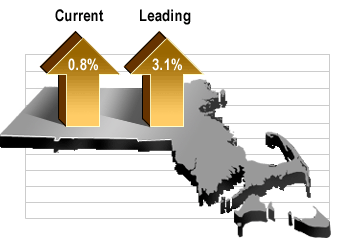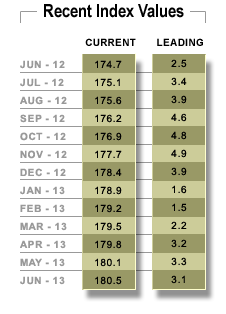State Economy Slows Significantly in the 2nd Quarter, UMass Journal reports
Federal austerity policies restraining the Bay State's economic recovery.
June 2013
 Massachusetts real gross domestic product grew at an annual rate of 0.8 percent in the second quarter of 2013 according to the latest MassBenchmarks Current Economic Index, released today by MassBenchmarks, the journal of the Massachusetts economy published by the UMass Donahue Institute in collaboration with the Federal Reserve Bank of Boston.
Massachusetts real gross domestic product grew at an annual rate of 0.8 percent in the second quarter of 2013 according to the latest MassBenchmarks Current Economic Index, released today by MassBenchmarks, the journal of the Massachusetts economy published by the UMass Donahue Institute in collaboration with the Federal Reserve Bank of Boston.
In contrast, U.S. real gross domestic product grew at an annual rate of 1.7 percent. In the first quarter of this year, Massachusetts real gross domestic product grew at an annual rate of 2.8 percent versus U.S. growth of 1.1 percent.
Economic growth in Massachusetts slowed sharply in the second quarter as compared to the first quarter. While fundamental measures of state growth — employment, earnings, and spending — soared in the first quarter, they fell back markedly in the second quarter. State payroll employment grew at an annual rate of 3.0 percent in the first quarter, but stalled in the second quarter, declining by 0.1 percent on an annualized basis. Massachusetts wage and salary income, which increased at an annual rate of 19.8 percent in the first quarter, fell at a 6.9 percent annual rate in the second quarter.1 Spending on items subject to the state's regular sales tax and the motor vehicle sales tax, which experienced robust growth (expanding at an annual rate of 11.8 percent in the first quarter), increased at a more modest 2.0 percent annualized rate in the second quarter.
 A slowdown in the second quarter was not unexpected. Fiscal austerity in the form of the expiration of the 2 percent payroll tax holiday and the federal budget cuts associated with sequestration were expected to impact state growth in the second quarter. Massachusetts, which is heavily reliant on federal funds to support its research and development at the Bay State's world-class hospitals, universities and innovation sectors, and a myriad of defense and other government contractors, appears to be bearing its disproportionate fair share of the impact of these policy choices.
A slowdown in the second quarter was not unexpected. Fiscal austerity in the form of the expiration of the 2 percent payroll tax holiday and the federal budget cuts associated with sequestration were expected to impact state growth in the second quarter. Massachusetts, which is heavily reliant on federal funds to support its research and development at the Bay State's world-class hospitals, universities and innovation sectors, and a myriad of defense and other government contractors, appears to be bearing its disproportionate fair share of the impact of these policy choices.
"The recent rise in unemployment is particularly disconcerting," noted Dr. Alan Clayton-Matthews, MassBenchmarks Senior Contributing Editor and Associate Professor of Economics and Public Policy at Northeastern University, who compiles and analyzes the Current and Leading indices. The proportion of the state's labor force that was unemployed rose from 6.4 percent in March to 7.0 percent in June. "It appears that unemployment rates increased for both men and women, and these increases were concentrated among youth — those less than 25 years old, and those with less than a high school education. However, unemployment rates also rose for those between the ages of 25 and 54, and for those with a high school diploma and some college but less than a Bachelor's degree,"2 Clayton-Matthews added.
The MassBenchmarks Leading Economic Index for June was 3.1 percent, and the three-month average for April through June was 3.2 percent. The leading index is a forecast of the growth in the current index over the next six months, expressed at an annual rate. Thus, it indicates that the economy is expected to grow at an annualized rate of 3.1 percent over the next six months (through December 2013). This implies the Commonwealth can expect third quarter growth of 2.8 percent, rising to 3.1 percent in the fourth quarter. Significantly, the Leading Index is not able to systematically consider the restraining effects on growth that slowed the state economy in the second quarter and consequently its predictions may be a bit rosy in the current environment.
While a rising stock market, the recovering housing market, long-awaited improvements in household balance sheets, and expected growth in global technology markets all bode well for growth prospects in the second half of 2013, it does not appear likely that federal budget policies will change during this same period. Consequently, it remains unclear as to whether the positive push represented by those factors driving state growth will be able to overcome the counterproductive pull of federal policy in the months to come.
 The 10 indicators that comprise the leading index usually do not all move in tandem. Typically, some may indicate an expectation of faster than average growth, while at the same time others may indicate an expectation of slower than average growth. The following table accounts for the contributions of each towards faster or slower growth than the long-term trend of 3.2 percent. The index value is their sum.
The 10 indicators that comprise the leading index usually do not all move in tandem. Typically, some may indicate an expectation of faster than average growth, while at the same time others may indicate an expectation of slower than average growth. The following table accounts for the contributions of each towards faster or slower growth than the long-term trend of 3.2 percent. The index value is their sum.
In June, four indicators contributed to a forecast of above-trend growth: consumer confidence, the Bloomberg stock index for Massachusetts, construction employment, and motor vehicle sales taxes. Three indicators contributed to below-trend growth: total nonagricultural employment, the unemployment rate, and initial unemployment claims. Three indicators contributed to average-trend growth: withholding taxes, sales taxes, and the interest rate spread between 10‑year and 3‑month U.S. Treasury securities.
In the three-month period April through June, four indicators contributed to a forecast of above-trend growth: total nonagricultural employment, the Bloomberg stock index for Massachusetts, construction employment, and motor vehicle sales taxes. One indicator, the unemployment rate, contributed to below-trend growth. Five indicators contributed to average-trend growth: withholding taxes, sales taxes, consumer confidence, the interest rate spread between 10‑year and 3‑month U.S. Treasury securities, and initial unemployment claims.
The current and historical quarterly estimates for state domestic product growth include adjustments for changes in productivity growth. These adjustments are estimates of the quarterly deviations from trend in the growth of the ratio of output to employment and output to wage and salary income. In the second quarter, these adjustments subtracted 1.3 percentage points from the annual rate of growth. In the first quarter, these adjustments subtracted 0.7 percentage points from the annual rate of growth. For the forecast of state domestic product growth for the third and fourth quarters of this year, productivity growth is assumed to return to its long-term trend.
Several recent months of the indices are revised each release. These revisions are a result of the statistical method used to create the index, as well as revisions in the underlying indicators.
--------
All of the indicators except interest rates refer to Massachusetts. The current index is composed of four indicators: nonagricultural employment, withholding taxes, sales taxes, and the unemployment rate. The leading index includes these four current indicators plus the other six (leading) indicators in the contributions table. All of the indicators are as of March, except for interest rates, and the Bloomberg stock index for Massachusetts, which are through July 25. The MassInsight Consumer Confidence Index is released every third month. Intervening months are interpolated, and changes in the Conference Board's Consumer Confidence Index for the U.S. are used to extrapolate to the current month of the index, as needed. Series measured in dollars, i.e., withholding taxes, sales taxes, the Bloomberg stock index, and motor vehicle sales taxes, are deflated by the U.S. consumer price index for all urban consumers, excluding food and energy.
For a description of the methodology used to construct these indices, see: Alan Clayton-Matthews and James H. Stock, "An application of the Stock/Watson index methodology to the Massachusetts economy," Journal of Economic and Social Measurement, vol. 25 (1998/1999), pp. 183-233.
--------
1) The estimates of wage and salary growth in both the first and second quarters are affected by estimates of the shift in earnings and withholding taxes from the first quarter of this year to the fourth quarter of last year due to expectations about changes in federal tax rates. These estimates assume that $80 million in December withholding taxes were shifted from January and February. If instead, only $40 million were shifted, the estimates of first and second quarter annualized growth rates in wage and salary income would be plus 7.0 percent and minus 1.6 percent respectively instead of plus 19.8 percent and minus 6.9 percent.
2) These estimates are based on 12-month moving averages from the Current Population Survey for Massachusetts (U.S. Bureau of Labor Statistics).
Dr. Alan Clayton-Matthews
MassBenchmarks
Northeastern University, School of Public Policy and Urban Affairs
July 31, 2013

